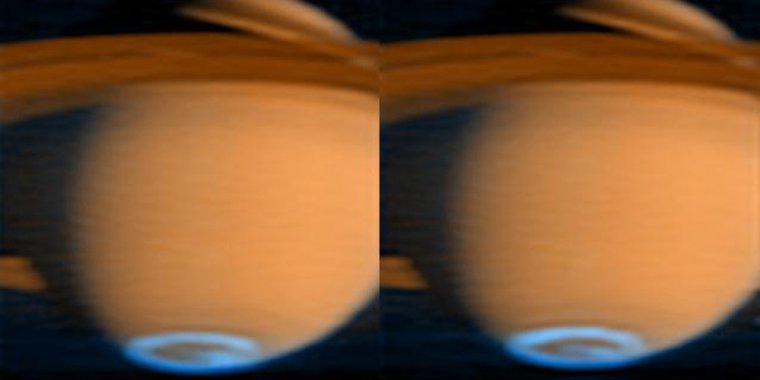| News / Space News |
Data From NASA's Cassini May Explain Saturn's Atmospheric Mystery
The upper layers in the atmospheres of gas giants - Saturn, Jupiter, Uranus and Neptune - are hot, just like Earth's. But unlike Earth, the Sun is too far from these outer planets to account for the high temperatures. Their heat source has been one of the great mysteries of planetary science.

The aurora at Saturn's southern pole is visible in this false-color image. Blue represents the aurora; red-orange is reflected sunlight. Photo: NASA/JPL/University of Colorado
New analysis of data from NASA's Cassini spacecraft finds a viable explanation for what's keeping the upper layers of Saturn, and possibly the other gas giants, so hot: auroras at the planet's north and south poles.
Electric currents, triggered by interactions between solar winds and charged particles from Saturn's moons, spark the auroras and heat the upper atmosphere.
The work is the most complete mapping yet of both temperature and density of a gas giant's upper atmosphere - a region that has, in general, been poorly understood.
By building a complete picture of how heat circulates in the atmosphere, scientists are better able to understand how auroral electric currents heat the upper layers of Saturn's atmosphere and drive winds.
The global wind system can distribute this energy, which is initially deposited near the poles toward the equatorial regions, heating them to twice the temperatures expected from the Sun's heating alone.
Managed by NASA's Jet Propulsion Laboratory in Southern California, Cassini was an orbiter that observed Saturn for more than 13 years before exhausting its fuel supply.
The mission plunged it into the planet's atmosphere in September 2017, in part to protect its moon Enceladus, which Cassini discovered might hold conditions suitable for life. But before its plunge, Cassini performed 22 ultra-close orbits of Saturn, a final tour called the Grand Finale.
It was during the Grand Finale that the key data was collected for the new temperature map of Saturn's atmosphere.
Understanding Saturn's upper atmosphere, where planet meets space, is key to understanding space weather, and its impact on other planets in our solar system and exoplanets around other stars. (NASA)
YOU MAY ALSO LIKE





